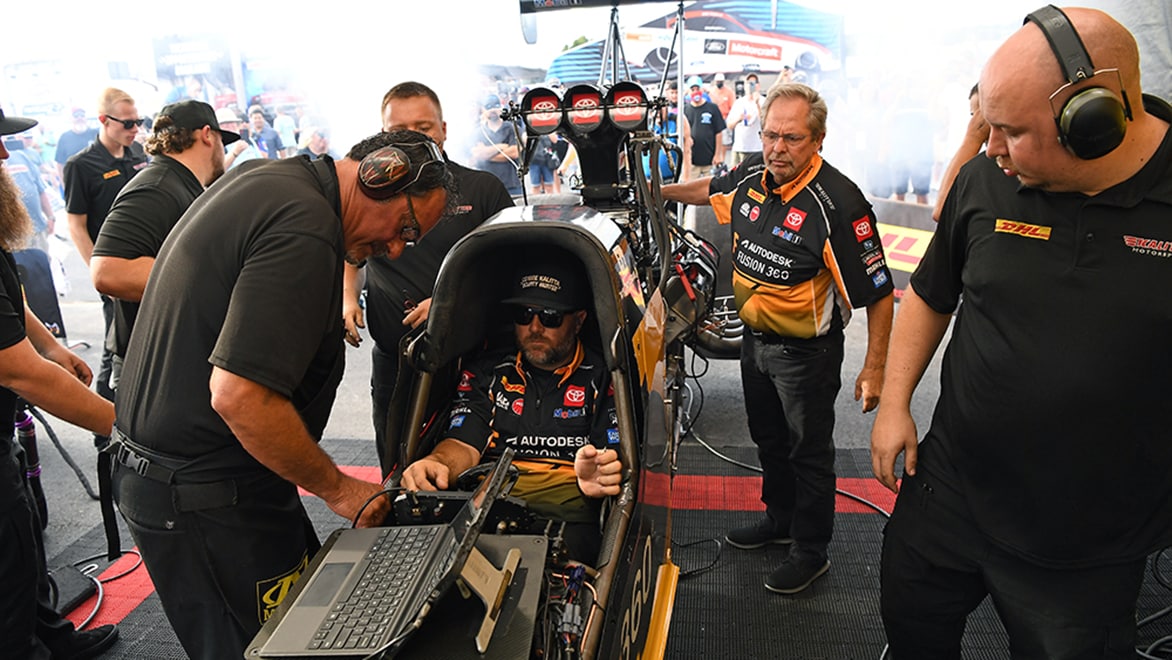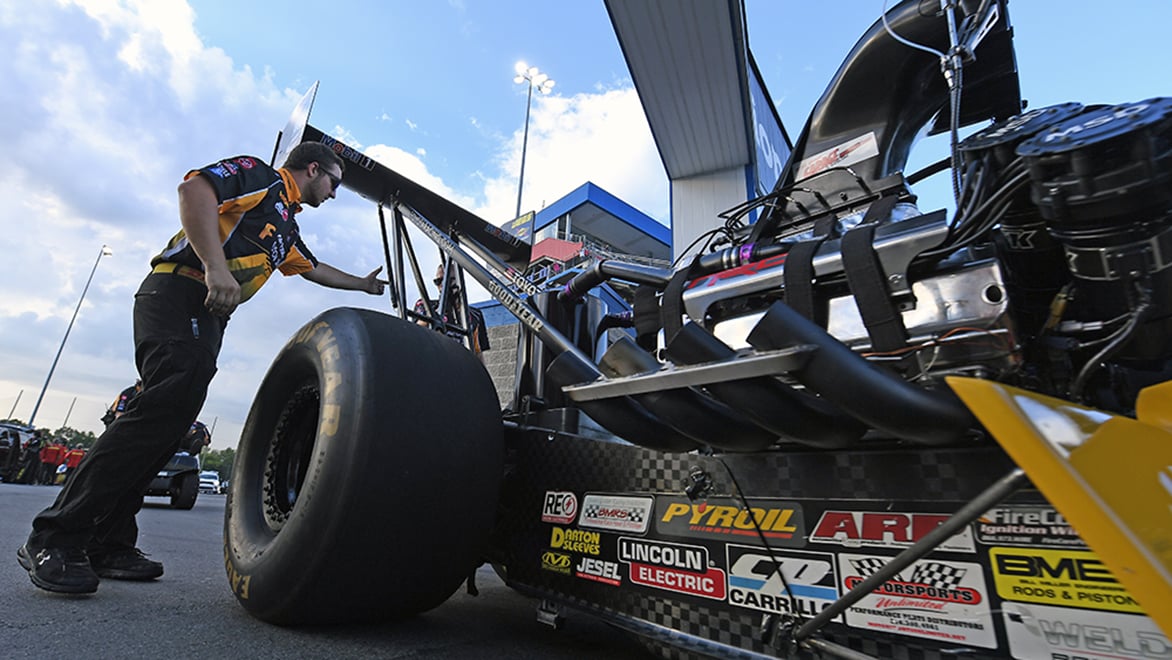KALITTA MOTORSPORTS
Drag racing with digital twins
DESIGN & MANUFACTURING
Share this story
Drag racing team saves manufacturing time and improves safety with the Product Design & Manufacturing Collection
Kalitta Motorsports creates product designs and expands manufacturing capabilities for their multi-time world championship drag racing team. The team has worked closely with Autodesk since 2015, and recently, Autodesk was the primary sponsor of Shawn Langdon’s 11,000 horsepower Top Fuel dragster during the DeWalt NHRA Carolina Nationals at zMax Dragway in Charlotte, North Carolina. Over 1,000 parts for the racing team are now designed and manufactured using Autodesk solutions in the Kalitta Motorsports CNC, chassis, and fabrication shop. By leveraging Autodesk technology, Kalitta has saved design and manufacturing time and resources and optimized their overall operations.

Pre-run warm up in pit area. Photo courtesy of Kalitta Motorsports.
Machining assemblies and more
Kalitta uses Autodesk Product Design & Manufacturing Collection–they design the clutch assembly in Autodesk Inventor and manufacture it using Autodesk best-in-class CAM machining solutions. Specifically, “adaptive” tool paths result in light, fast and constant-engagement strategies that widely replace slower, heavier cuts. The resulting improvements in tool life and performance have reduced machining time on main clutch components from 30 hours to 10 hours.
“We have built our entire parts manufacturing and design program with the help of Autodesk technology,” said Chad Head, General Manager at Kalitta Motorsports. “We started in 2015 machining our clutch assemblies and now we are doing clutch assemblies, cylinder heads, and so many more parts. It is a huge cost savings and so much more efficient. The Autodesk software is a game-changer for us, and they are an integral part of our success at Kalitta Motorsports and Kalitta Air.”
Improving safety and reliability with a digital twin
Since the inception of their relationship with Autodesk, a key initiative for Kalitta Motorsports has been to digitize their race teams, which led to the creation of digital twins of their race cars.
“Our work with Kalitta Motorsports is a great example of how technology can improve the safety, reliability and performance of complex assemblies in automotive applications,” said Scott Reese, Executive Vice President, Product Development and Manufacturing Solutions at Autodesk. “Kalitta uses our software to create digital twins for its high-performance racing components, which means our role is to help them capture and model data, then rapidly extract insights from that data to deliver better outcomes. We’re thrilled to be working with the champions at Kalitta to help improve their performance on and off the track.”

Staging lane area leading up to qualifying attempt. Photo courtesy of Kalitta Motorsports.
From simulation to solution
Having a digital twin of their race cars allows Kalitta to do numerous simulations and identify the optimal solution before deploying valuable resources to implement the changes. The Product Design & Manufacturing Collected enables Kalitta to easily implement these changes in-house by expanding their capabilities to include chassis fabrication and CNC operations to manufacture their own parts, including carbon fiber bodies and safety products specific to their teams.
The initial goal was to build chassis jigs to allow them to build a complete dragster or funny car in house. From a performance perspective, Kalitta focused on the clutch assemblies as it is a constant evolution component that is critical to their car’s performance. The work starts at the race shop with machining the titanium pieces of the clutch assembly. Just one of these components can weigh almost 100 pounds and be 14 inches in diameter. Machining the parts while maintaining accurate tolerances plays a significant role in the overall performance of the clutch, while fighting for those tough to get wins at the track.
"We started in 2015 machining our clutch assemblies and now we are doing clutch assemblies, cylinder heads, and so many more parts. It is a huge cost savings and so much more efficient. The Autodesk software is a game changer for us, and they are an integral part of our success at Kalitta Motorsports and Kalitta Air."
—Chad Head, General Manager, Kalitta Motorsports

Qualifying run in preparation for race day. Photo courtesy of Kalitta Motorsports.
Leveraging AnyCAD
Improvements in overall operations helped Kalitta continue to digitize even more of their organization and expand their journey towards creating a full-fledged digital twin. To do so, the Kalitta team took on designing and manufacturing their own cylinder heads. Bringing the design in-house allowed them to reduce spend and improve performance and reliability throughout the race season and added an even more robust portfolio to the existing one thousand plus parts that are already created using Autodesk solutions (including numerous aviation parts for Kalitta Air).
The original cylinder head design was developed in Solidworks, and the machining tool paths are done in Autodesk Inventor CAM. By leveraging Autodesk AnyCAD technology, Kalitta could easily reference in the Solidworks cylinder head model and create the tool paths in Inventor CAM. If the Solidworks model changed, Autodesk AnyCAD technology would see the changes, and the model would update to the latest version and the tool paths that were created using Inventor CAM.
Saving time with feature-based conversion technology
To establish even more efficiency in their process, Kalitta decided that they wanted the digital twin of their cylinder head design to be on the same Autodesk platform as the rest of their files. This posed an initial challenge, because the race team did not have the significant amount of time on their hands that it would take to start from scratch and re-model the cylinder head in Autodesk Inventor. Leveraging ITI’s GoToINVENTOR feature-based conversion technology, the Kalitta team was able to take the original Solidworks file and convert each feature and sketch to an Autodesk Inventor part file.
And the result? Saving an impressive 80+ hours of the Kalitta team’s time. Going forward, Kalitta plans on continuing to further leverage data from their digital twins to find efficiencies–both on the shop floor and on the track.
See related products
-
Professional-grade product design and engineering tools for 3D mechanical design, simulation, visualization, and documentation.
-
Get Inventor + AutoCAD + Autodesk Fusion + more—Professional-grade tools for product development and manufacturing planning.
Realize robust interoperability
CAD interoperability with Autodesk enables you to seamlessly exchange CAD data from virtually any source, while maintaining your data integrity.



